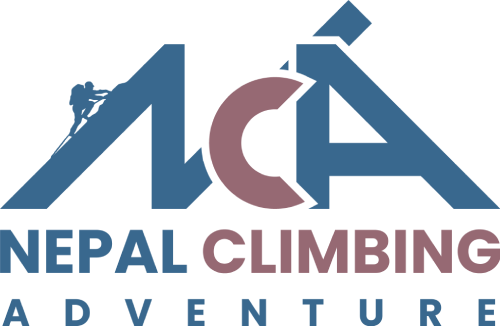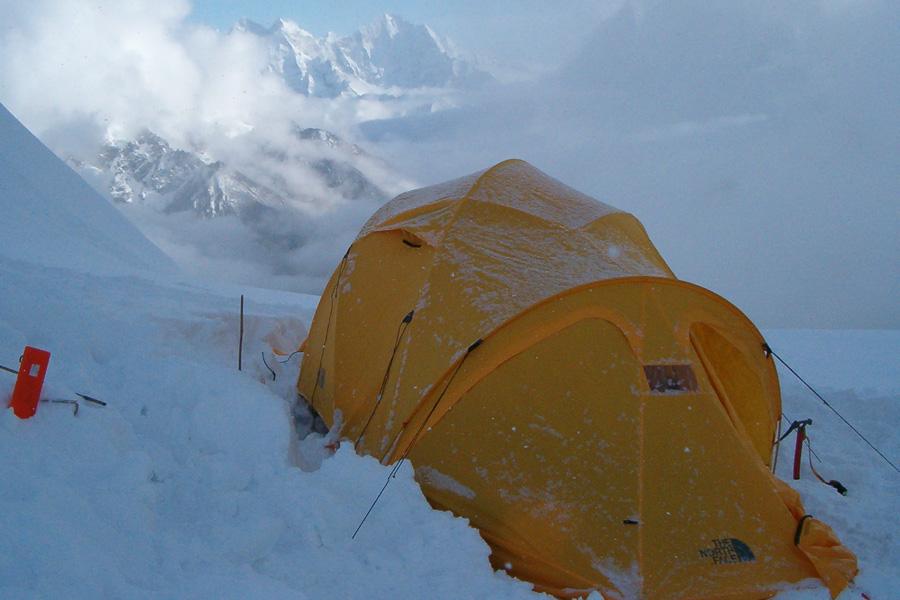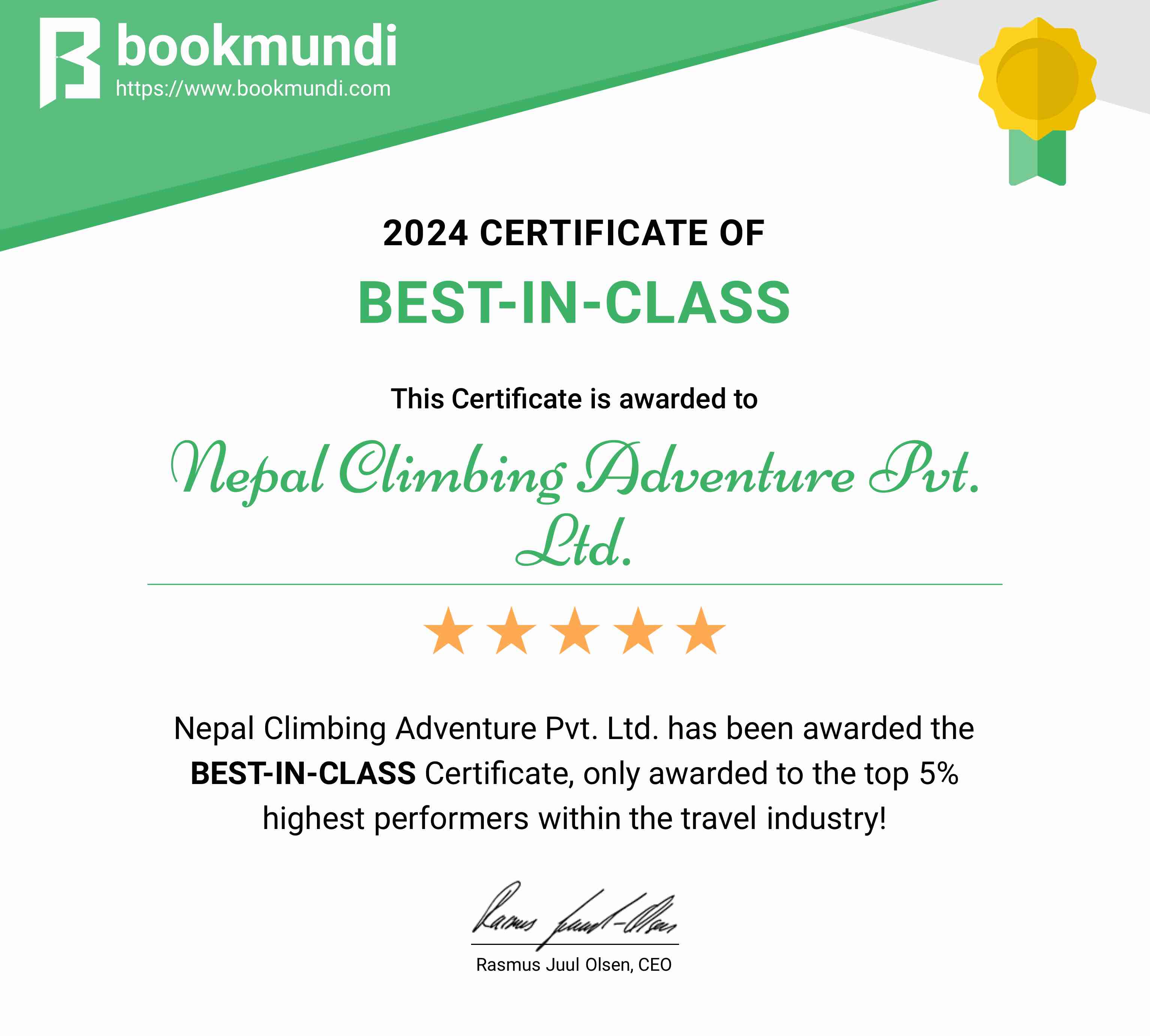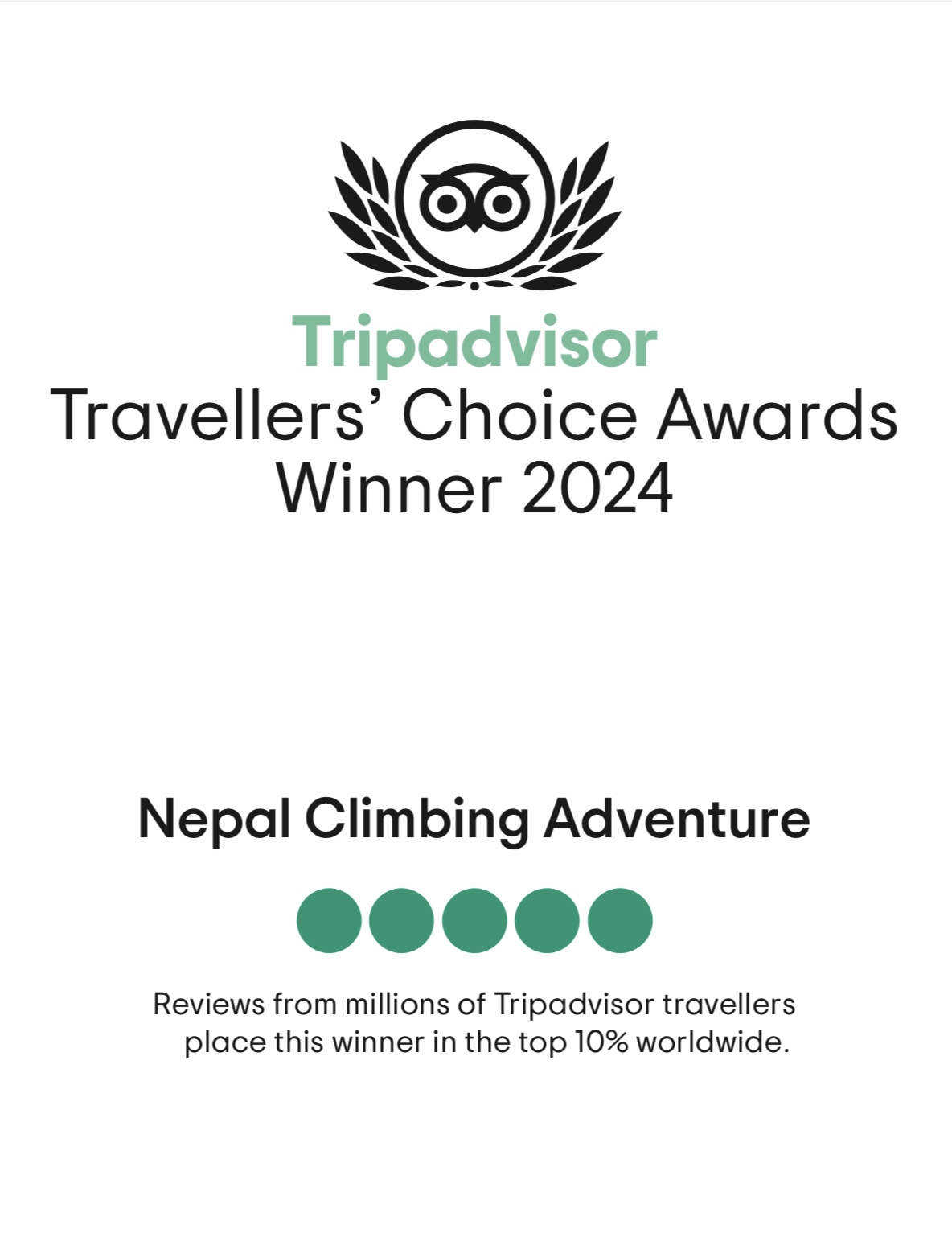Amadablam Expedition is one of the most technical and challenging climbing adventures in Nepal with an elevation of 6812m. Check out the best itinerary, Season, and Cost to Climb Ama Dablam.
Overview:
The staggering Ama Dablam mountain(6812m) is one of the world’s most lovely and mesmerizing peaks. It stands impressively tall amidst several other mountains in the Everest region. The Ama Dablam Expedition is one of the most technical and challenging climbing adventures in the Himalayas.
Mount Ama Dablam has an enduring impact on numerous trekkers in Nepal, as it is maybe the most dazzling mountain during the trekking to Everest Base Camp. Mt. Ama Dablam offers a delightful sight south of Mt. Everest and Mt. Lhotse in the Khumbu region of the Himalayas. It is a lofty pyramid of ice with vertical dividers and sharp, uncovered edges.
The climb goes through the Southwest edge of the Ama Dablam mountain which is the normal route to climb. This Ama Dablam Climbing route has three camps above the base camp. You will need to have previous climbing experience for this Ama Dablam Expedition tours as it demands high technical skills. In addition to being a technical mountain, it is also a highly challenging mountaineering expedition to Mt. Ama Dablam adventure. Although a six thousand meter mountain, it is an expedition mountain, unlike the other peak climbing.
You will find the mountain to be the most dominant mountain of all in the region. But climbing this mountain is a daring task that requires you multiple days, training, skills, and experience. Ama Dablam Climbing Expedition offers a thrilling climbing experience to the mountaineers.
Reasons this Expedition Becomes an Experience
Nepal Climbing Adventure always strives to offer an adventure traveling experience that you can cherish. While the Ama Dablam Expedition is beautiful in its all essence, your experience of trekking there becomes even more beautiful with us.
By the time we take you to the base camp and bring you back, we take one step ahead to offer you a beautiful Ama Dablam climbing experience. We keep your safety and happiness is our top priority and you will experience the same during the trip.
Going on the Ama Dablam Expedition with us is traveling in safe hands.
Ama Dablam Climbing History:
Ama Dablam Nepal is located in the Himalayas and is renowned for its stunning beauty and challenging ascent. Its name translates to "Mother's Necklace" due to its ridges resembling a mother's arms embracing her child. First climbed in 1961 by a team of climbers from New Zealand, Ama Dablam has since become a coveted peak for mountaineers worldwide. The initial successful expedition was led by Sir Edmund Hillary, who famously summited Mount Everest in 1953. The route they pioneered, via the Southwest Ridge, remains the most popular to this day. Climbers are drawn not only to the technical difficulty of Ama Dablam but also to its aesthetic appeal, with its dramatic ridges and icy slopes.
Over the decades, we have witnessed numerous Ama Dablam ascents, with climbers from different countries attempting various routes and variations. Despite its challenging nature, the Ama Dablam Peak attracts both experienced mountaineers and those looking to push their limits. The Ama Dablam climb typically involves technical rock climbing, steep ice sections, and exposed ridges, requiring a high level of skill and experience. The altitude, standing at 6,812 meters (22,349 feet), adds to the difficulty, necessitating careful acclimatization and logistical planning. Ama Dablam holds a special place in the hearts of climbers not only for its physical demands but also for its breathtaking views of surrounding peaks like Everest, Lhotse, and Makalu. Its striking appearance against the Himalayan backdrop ensures its enduring allure among adventurers seeking both challenge and beauty in the world of mountaineering expeditions to Mt. Ama Dablam.
Best Time for Ama Dablam Expedition:
The best time to Climb Ama Dablam expedition typically falls within the pre-monsoon (spring) and post-monsoon (autumn) seasons in Nepal, which are considered the optimal periods for mountaineering in the Himalayas. In particular, the months of April to May and late September to October are favored due to favorable weather conditions and clearer skies, which are crucial for the Ama Dablam summit.
During the spring season (April to May), climbers benefit from stable weather patterns and moderate temperatures, which facilitate safer Ama Dablam ascents and better visibility. The days are longer, providing more daylight hours for climbing and ensuring adequate time for acclimatization. This period is also known for the blossoming rhododendrons, adding natural beauty to the trekking Ama Dablam climbing routes leading to the base camp.
The autumn season (late September to October) offers similar advantages, with stable Ama Dablam weather conditions, clear skies, and relatively mild temperatures. This Ama Dablam Climbing season follows the monsoon rains, which help to clear the atmosphere of dust and pollutants, offering stunning views of the surrounding peaks and valleys. The stable weather during autumn reduces the risks associated with sudden storms or adverse weather changes, making it safer and more predictable for climbers to attempt the challenging routes of Ama Dablam Trek.
Both seasons attract mountaineers from around the world seeking to conquer Ama Dablam trekking, known for its technical challenges and striking pyramid-shaped peaks. However, climbers must still prepare for extreme altitude and challenging terrain, regardless of the chosen Ama Dablam Climbing Season. Ultimately, the choice between spring and autumn depends on personal preference, timing, and logistical considerations, but either period offers an unforgettable adventure in the heart of the Himalayas.
Ama Dablam Expedition Cost:
The trek cost for Ama Dablam expedition varies widely based on several factors. Typically, a guided expedition with an experienced team can range from $30,000 to $40,000 per person. This cost usually includes permits, logistics, accommodation, food, guides, and equipment such as ropes and tents. Additional costs may include travel to and from Kathmandu, Nepal, where most expeditions to Ama Dablam begin. The high cost reflects the challenges and risks involved in climbing Ama Dablam, known for its technical climbing sections and high altitude. It also covers the extensive support needed to ensure climbers' safety and success.
Ama Dablam Expedition Guides and Sherpas help climbers through difficult sections and provide logistical support at base camps. Expeditions typically last around four to six weeks, allowing time for acclimatization and multiple attempts to reach the Ama Dablam summit. The Ama Dablam climb itself requires advanced mountaineering skills, including ice and rock climbing techniques, making it suitable for experienced climbers looking to tackle one of Nepal's most iconic peaks. While the cost may seem high, it reflects the comprehensive support and planning required for a safe and successful ascent of Ama Dablam, ensuring climbers have the best possible chance of reaching the summit while managing the inherent risks of high-altitude mountaineering expeditions to Mt. Ama Dablam.
Ama Dablam Climbing Permits:
Climbing permits for Ama Dablam, a majestic peak in the Himalayas, are essential for adventurers seeking to conquer its challenging slopes. Located in the Everest region of Nepal, Ama Dablam stands at 6,812 meters (22,349 feet) and is renowned for its steep ridges and stunning views. Permits for climbing Ama Dablam are issued by the Nepalese government through the Department of Tourism. These permits are necessary to ensure safety and manage the impact on the environment. Climbers typically obtain these permits through registered Ama Dablam expedition 2024 operators who facilitate the bureaucratic process.
The cost of permits can vary depending on the season and the number of climbers in the group. Spring and autumn are the primary climbing seasons due to more favorable Ama Dablam weather conditions, and permits are in higher demand during these times. The permit application process includes providing detailed climbing itineraries, emergency evacuation plans, and proof of insurance coverage for each climber. This rigorous process helps authorities ensure that climbers are adequately prepared for the challenges of Ama Dablam and can respond to emergencies effectively. Climbing during the off-season is possible but requires careful planning and consideration of Ama Dablam weather and safety factors.
Most technically demanding Ama Dablam peaks in the region require climbers to have previous high-altitude experience and strong technical climbing skills. The route to the summit involves mixed rock, ice, and snow climbing, with sections of steep pitches and exposed ridges. Obtaining climbing permits for Ama Dablam involves careful planning, compliance with regulations, and preparation for the physical and technical challenges of the climb. It is an adventure that attracts experienced mountaineers seeking to test their skills in one of the world's most breathtaking and challenging environments.
Ama Dablam Altitude:
Ama Dablam is a majestic mountain located in the Everest region of Nepal, renowned for its stunning beauty and challenging climbing routes. The Ama Dablam altitude, or height above sea level, is approximately 6,812 meters (22,349 feet). The name "Ama Dablam" translates to "Mother's Necklace," reflecting its distinctive shape that includes a long ridge and a hanging glacier. Climbing Ama Dablam is considered highly technical and requires significant mountaineering skills due to its steep faces and unpredictable weather conditions. The first successful ascent of Ama Dablam was made in 1961 by a team of climbers from New Zealand, the United States, and the United Kingdom.
The mountain is part of the Himalayan range and is situated near the popular trekking route to Everest Base Camp, making it a prominent landmark visible from various vantage points along the trekking trails. Its pyramid-shaped peak and the exposed granite rock faces attract climbers from around the world seeking both the challenge of the ascent and the breathtaking views from the summit. Due to its altitude and the nature of its terrain, climbing Ama Dablam requires careful planning, technical proficiency in ice and rock climbing, and the ability to acclimatize to high altitudes.
Expeditions typically involve establishing several camps along the route to the summit, with climbers navigating through ice cliffs, snowfields, and challenging ridges. In recent years, Ama Dablam has become increasingly popular among experienced climbers seeking a significant challenge outside of the more frequented peaks like Everest and Lhotse. Its combination of technical difficulty and stunning scenery continues to make it a coveted objective for mountaineers and a symbol of the adventurous spirit of Himalayan exploration.
Ama Dablam Expedition Difficulty Level:
Ama Dablam is renowned as one of the most challenging and technically demanding peaks in the Himalayas. Situated in Nepal's Khumbu region, its striking pyramid shape and steep faces require climbers to possess advanced mountaineering skills. The Ama Dablam expedition 2024 is considered highly difficult due to its steep terrain, unpredictable weather, and the technical expertise needed to navigate its various routes.
Climbers attempting Ama Dablam face a mix of rock, ice, and snow conditions, which demand proficiency in both rock and ice climbing techniques. The ascent often involves using fixed ropes, ice screws, and other technical gear to navigate through challenging sections. The exposure to high altitudes further adds to the difficulty, requiring climbers to acclimatize properly and manage potential altitude-related risks.
The climbing routes on Ama Dablam vary in difficulty, with the Southwest Ridge being the most popular and technically challenging route. Climbers encounter steep rock sections, traverse across exposed ridges, and technical ice climbs on their way to the summit. The mountain's unpredictable weather, including high winds and sudden storms, can also pose significant challenges and increase the complexity of the expedition.
Successful ascents of Ama Dablam require careful planning, physical endurance, technical proficiency, and a high level of mental resilience. Climbers often spend several weeks acclimatizing and preparing at base camp before attempting the summit. Overall, Ama Dablam remains a coveted but formidable objective for experienced mountaineers seeking a significant challenge in the Himalayas.
Ama Dablam Death Rate:
Ama Dablam, a prominent mountain in the Himalayas, has a reputation for its challenging ascent and the risks associated with climbing it. The death rate on Ama Dablam is not easily quantified due to varying factors such as climbing experience, weather conditions, and individual health. However, like many high-altitude peaks, Ama Dablam poses significant hazards including avalanches, crevasses, and extreme weather. Climbers face dangers like altitude sickness, falling ice, and technical climbing difficulties, which contribute to the overall risk. The death rate fluctuates from year to year and can be influenced by the number of climbers attempting the summit and their level of preparedness.
Despite safety measures and advances in equipment and techniques, fatalities have occurred due to falls, avalanches, and medical complications exacerbated by high altitude. Experienced climbers often emphasize the importance of thorough Ama Dablam Expedition preparation, including physical conditioning and understanding the technical challenges. Rescue operations on the mountain are challenging due to its steep terrain and remote location, further complicating emergencies. While ama dablam deaths aren't consistently reported in precise statistics, climbers and mountaineers recognize the inherent risks involved in attempting such a demanding peak in the Himalayas. Understanding these risks and preparing accordingly are crucial steps in minimizing the dangers associated with climbing Ama Dablam.
Ama Dablam Expedition Itinerary Details:
Day 01: Arrival at Kathmandu
Ama Dablam expedition itinerary begins upon your arrival. After you arrive at the airport, you will be received by our representatives and taken to the hotel. After you check in, you will meet your traveling companions and a welcome dinner will be organized in the evening where you will be served original Nepali cuisine and introduced to Nepali culture.
- Accommodation: Hotel
Day 02: Sightseeing in Kathmandu and Ama Dablam Expedition Preparation
After having breakfast, you will be briefed about the composition of your team, travel equipment, and the nature and strategy of the expedition. All official procedures will be finalized and necessary arrangements will be made. Then there will be a guided tour of the major landmarks and world heritage sites of Kathmandu Valley like Kathmandu Durbar Square, Pashupatinath, Swayambhunath, and Boudhanath. In the afternoon, there will be a pre-discussion before the trip and the final preparation will be done.
- Accommodation: Hotel
- Meal: Breakfast
Day 03: Fly to Lukla and trek to Phakding
A 30-minute flight early in the morning will be required to reach Lukla. After arrival, you will be introduced to trek guides and porters. The trek starts with a short walk to Chaurikharka village and descends towards Dudh Koshi valley. The trail follows the Dudh Koshi River to reach Phakding village where we spend the night.
- Accommodation: Guesthouse
- Meal: Breakfast, Lunch and Dinner
Day 04: Trek to Namche Bazaar
After breakfast, we leave Phakding village for Namche Bazaar. It follows over the Dudh Koshi river by a suspension bridge into a pine forest. We arrive at the check post and entrance to Sagarmatha National Park and descend through the Dudh Koshi River. We pass through Josale village before reaching Namche Bazaar where we stay overnight in a local lodge.
- Accommodation: Guesthouse
- Meal: Breakfast, Lunch and Dinner
Day 05: At Namche Bazaar
Today will be acclimatization day in Namche Bazaar. In the morning after breakfast, we visit the Sherpa Museum. We will also visit local shops for necessary equipment and clothing. In the afternoon we visited villages near Namche Bazaar. We return to the lodge and spend overnight
- Accommodation: Guesthouse
- Meal: Breakfast, Lunch and Dinner
Day 06: Trek to Tengboche
After breakfast, we ascend out of the village along the trail. Along the trail Everest, Nuptse and Lhotse, and other Himalayan peaks can be observed. A gradual uphill ascent will be required on the steep trail. We follow the yak trails towards Tengboche Monastery and tour across its premises. We stayed overnight below the monastery at a local lodge.
- Accommodation: Guesthouse
- Meal: Breakfast, Lunch and Dinner
Day 07: Trek to Dingboche
Today we woke up right on time to go to morning prayers and to get blessings from the senior monks at Tyangboche Monastery. Subsequent to completing the prayers, we will leave Tyangboche and trek through delightful woodland towards Deboche. Our trail slips to cross an extension bridge before climbing steeply for 60 minutes to reach Pangboche. From Pangboche we will take after the Imja Khola that prompts to the major intersection of the trail. The left pathway leads to Pheriche, yet we turn right and trek towards Dingboche.
- Accommodation: Guesthouse
- Meal: Breakfast, Lunch and Dinner
Day 08: Trek to Ama Dablam Base Camp Expedition
From Dingboche our trek proceeds through dense vegetation. It is a fairly short day of trekking yet is a continuous climb to Amadablam Base Camp. We will trek until we achieve the broad fields at 4,800 meters where our Base Camp will be set upon. When we reach our campground, our Sherpa group will set up the base camp and begin making important arrangements for setting up higher camps above base camp and finding the course to the summit of Mt Amadablam.
- Accommodation: Camping
- Meal: Breakfast, Lunch and Dinner?
Day 09 - 26: Summit Mt. Amadablam [6812m/22343ft] and back to Base Camp
We will spend a few days participating in the preparation of the Ama Dablam spring expedition with satisfactory days for acclimatization. Taking after the footsteps of our accomplished climbing Sherpa guides, we move higher and nearer to the summit. Completely furnished with all the Ama Dablam climbing gears, we will sit tight for a great climate condition and head towards the summit of one of the testing and technical moving high peaks on the planet. Our tiring move to the summit of Mt. Amadablam is compensated with staggering perspectives of Everest, Lhotse, Nuptse, Cho Oyu, Baruntse, and other encompassing high tops in the Khumbu area. We will invest short energy at the summit before we begin to drop down after a similar course back to the base camp.
- Accommodation: Camping
- Meal: Breakfast, Lunch and Dinner
Day 27: Trek back to Tengboche
After the fruitful accomplishment of our objective - the summit of Mt Amadablam, we will make a casual beginning and get ready for our reverse trekking. We begin our trek by following our trail back to Pheriche. Our trek joins the fundamental EBC trail towards Pangboche. It is for the most part downhill trekking from Pangboche until we reach Deboche. At that point, we will take a rising trail to reach Tengboche.
- Accommodation: Camping
- Meal: Breakfast, Lunch and Dinner
Day 28: Trek to Namche Bazar
We trek down through the hillside and reach Phunki Tenga. Here we descend following the Dudh Koshi River trail through pine forest. We reach at Kyanhjuma through Sansa and follow the trail towards Namche Bazaar where overnight is spent at a local lodge.
- Accommodation: Guesthouse
- Meal: Breakfast, Lunch and Dinner
Day 29: Trek to Lukla
The trek from Namche Bazaar follows Monjo to Lukla. The trail is of short climbs and across Bhote-Koshi River. The last uphill climb brings us to Lukla where we spend the night.
- Accommodation: Guesthouse
- Meal: Breakfast, Lunch and Dinner
Day 30: Fly to Kathmandu
In the morning after breakfast, we take a brief flight of about 40 minutes to Kathmandu. You will be transferred to your hotel where you can get your much-needed rest. Upon your will, you can visit the Thamel area or other nearby places. In the evening, you will be served a farewell dinner which basically includes delicious Nepali cuisine.
- Accommodation: Hotel
- Meal: Breakfast and Lunch
Day 31: Rest at Kathmandu & Debriefing
Today, you will be visiting the Department Of Tourism for a debriefing of the expedition and receiving the certificate of accomplishment.
- Accommodation: Hotel
- Meal: Breakfast
Day 32: Departure from Tribhuvan International Airport
This will be the day you bid farewell to Nepal after your lifelong memorable and awe-inspiring trip. Our representatives will help you to the airport.
- Meal: Breakfast
What is included?
- All types of organizational requirements
- All trekking and climbing paper works and permits
- All airport and hotel transfers
- Welcome and farewell dinner
- Accommodation and meals during the whole of the expedition
- Flight from Kathmandu to Lukla and back
- Government and local taxes
- Reference notes to plan your trip
- An experienced English-speaking climbing guide, assistant climbing guide, and Sherpa porters including their salary, insurance, food, lodging, and all equipment
- A comprehensive medical kit
- Facilities of Email and satellite phones in base camp
- Necessary oxygen bottles
- Written and photo internet dispatches to send your progress to your family
What is not included?
- Nepal Visa fee(bring small denomination cash USD and two passport photographs)
- International airfare
- Excess baggage charges
- Extra night accommodation apart from the schedule due to any reasons
- Lunch and evening meals in case of early return than the scheduled itinerary
- Travel and rescue insurance
- Charges of Email and satellite phones
- Charge for extra Sherpa porter (if required)
- Personal expenses
- Tips for climbing guide and Sherpa
There are a number of things that you need to keep in mind if you ever plan for your vacation. Because you want to make the most out of your limited time, it is truly a hectic job for you to find a trustworthy and experienced traveling companion. With Nepal Climbing, you have your problem solved already as we are one of the leading Trekking and Mountaineering organizations in Nepal and have been providing first class service in several travelling packages across the country for many years.
We prioritize your satisfaction and safety
At Nepal Climbing Adventure, our ultimate objective is to arrange the programs for you to make the most out of your valuable time. We value your satisfaction, adventure, amusement and safety. Regardless of whether you are searching for stunning perspectives along the trekking trails in Himalayan mountain range or widely acclaimed, heavenly attractions with developed societies, our exposure and experience in travel business will help you ensure your requirements are met.
We have professional staffs and service
We trust that extraordinary staff lead awesome administration. That is the reason we are collaborated with experienced and eager individuals. We possess authorized and government certified guides who are very much furnished with broad learning of Nepali communities and traditions. They additionally have familiar English speaking abilities and hierarchical capacities to encourage all types trekking groups.
Responsible Tourism and social values
We are endeavoring to lessen the effect of tourism by guaranteeing our staff are very much aware of ecological issues. We are doing our best to create less waste as could be expected under the circumstances and make a point to reclaim non-compostable wastes. We outline our itineraries and work in the field guided by the standards of ecotourism and reasonable tourism. Moreover, all our staff have been given ecological preparing and are extremely aware to the eco-system we enter. Additionally, we are adhering to sustainable assets of energy. Our guides will share you the social values, culture and religious harmony for better understanding the groups you visit.
Customizable Service
Our promise is to provide you with the travelling packages customizable according to your demand fulfilling your budget criteria. So, we can facilitate a minimum of 2 individuals with a personalized service at a reasonable cost.
Online Payment
Or
WIRE TRANSFER
Bank Details:
Account Holder's Name: Nepal Climbing Adventure Pvt. Ltd.
Bank Name: Himalayan Bank Ltd.
Account Number: 01907449340018
Account Type: USD
Address: Thamel, Kathmandu, Nepal
SWIFT CODE: HIMANPKA
For more detail contact us:
Krishna Subedi (Chris Chhetri): +977 9851076791 (24/7, Call/Viber/Watsapp)
We recommend our guests have a valid insurance policy before undertaking an adventure in Nepal Himalaya. During treks and expeditions, the insurance should cover for expenses such as air ambulance, helicopter rescue, and medical care. As an adventure operator, we (NCA), are not permitted to arrange or sell insurance packages here in Nepal as per the Government of Nepal.
Frequently Asked Questions (FAQs):
1. Are you a licensed adventure company?
Yes, we are a licensed company to operate adventure tours in Nepal. We have been organizing tours, Treks, and Expeditions for our valued clients for over two decades. Our long journey and experience in the field have made us pioneers in the industry.
2. Do the guides speak English and have first aid training?
All of our guides are experienced experts in their job and speak fluent English. Most of them are born in the areas they guide trekkers to and have several years of experience as trekking guides in the mountains. It's mandatory that they are trained in first aid and also carry a first aid kit with them during the trek.
3. How big are the groups?
We always do our best to team up a small group of like-minded people to give them a memorable and insightful adventure travel experience, coupled with an invaluable opportunity to interact with each other in the true spirit that comes with adventure. Our trek groups generally comprise of maximum 12 members. We need a minimum of 2 participants to run our fixed departure dates. For private trips, no minimum or maximum numbers apply.
4. Are permits included in the price of the adventure?
Yes. All of the necessary permits for your trekking, climbing, and expedition are included in the price and will be arranged for you prior to your trek. For certain restricted regions (like Manaslu and Makalu), you'll need to have a full day in Kathmandu prior to your trek as your trek operator will need your passport for the permit registration.
5. Do you arrange private adventures?
We offer customizable trips for individuals, families, and groups up to 100, with flexible dates and negotiable costs based on group size, trek area, duration, and style. Solo travelers, including single women, are welcome and will be provided with trustworthy local guides and porters. Whether you want to join a fixed departure or travel solo, we ensure a safe and enjoyable trekking experience.
6. Do you provide any equipment while trekking?
On our camping treks, we provide tents, foam mattresses, cooking equipment, lanterns, tables, stools, and main meals. Tea house treks require no additional equipment. Tents are usually shared between two people. However, if you do not have a duffel bag, one will be provided to you. Similarly, if you have not brought your own down jacket, one will be given to you. These items are loaned to you and must be returned once the trek is completed.
7. How difficult are the treks?
Trek difficulty in the Himalayas varies by fitness, experience, trail steepness, altitude, and duration. Lower foothill treks like Ghorepani and Poonhill are moderate, while higher-altitude treks like Everest Base Camp and Annapurna Circuit are more challenging due to 5,000m passes. Avid hikers will find trekking an unparalleled adventure.
8. How long do we walk each day?
Our treks are classified into three categories: Soft Adventure (1 week, below 4000m, 4-5 hours walking daily), Moderate to Fairly Challenging (longer, high-altitude, 6-8 hours daily), and Arduous (extended, remote, 7-9 hours daily, physically and mentally demanding). Arduous treks are not for beginners.
9. What is exactly 'teahouse' trekking?
Teahouse trekking involves staying in small, cozy local lodges with basic amenities, typically run by the community. These lodges provide shelter from mountain winds and offer a true sense of life in the wild. Most treks in Nepal follow this format.
10. What do we mean by FOT trek?
On Fully Organized Treks (FOT) or Camping Treks, all meals and sleeping arrangements are handled by a support crew, including a sirdar, cook, kitchen crew, Sherpa assistants, and porters. FOTs are also known as CAMPING TREKS. You'll sleep in tents, with Sherpa assistants guiding the way and porters transporting gear.
11. What is security like during trekking?
Client security is our top priority, with licensed, reliable guides and support crew. On camping treks, keep your bag inside your tent and avoid leaving it unattended. At night, a Sherpa guards the campsite. On tea house treks, always lock your room and never leave belongings unattended.
12. What happens if I fall ill during the trek?
If you fall ill during your trek, the response depends on the illness. For altitude sickness, descend and take medication; severe cases may require emergency helicopter evacuation, so ensure your insurance covers this. For stomach or other common illnesses, your guide will have the necessary medication.
13. What type of food is served during a trek?
On camping treks, we provide three nutritious meals daily, featuring a mix of local and western dishes including hearty breakfasts and satisfying dinners with desserts. We prioritize hygiene with well-cooked food, treated water, and sanitation measures. On tea house treks, standard meals are provided with options for special dietary needs, ensuring trekkers are well-nourished throughout their journey.
14. Do I need to carry my own gear?
Ama Dablam Climbing Gear is carried by the porters for the longer trek, allowing you to focus on essentials like sunblock and camera. Shorter treks may only require a guide if you prefer carrying your own gear, but hiring a porter supports the local economy and ensures safety, especially in challenging mountain environments.
15. How much could porters carry?
Porters on our treks carry up to 30 kg to ensure their safety and well-being. Fragile items like cameras are best carried by trekkers themselves, and any additional weight beyond 15 kg should be managed in your day pack. We adhere strictly to IPPG guidelines to ensure fair treatment and respect for our porters.
16. What is overnight accommodation like?
In Kathmandu or Lhasa, you can choose from a range of hotels from luxury to budget. On treks, accommodations vary: camping trips use tents while tea house treks stay in basic but cozy lodges run by local families. Tea house treks are more economical and suitable for small groups, though private rooms may not always be available in peak seasons, adding to the adventure.
17. Can we change the itinerary?
You can adjust the trek itinerary to some extent after consulting with your senior guide, ensuring the trek's completion aligns with the original plan. Given the remote and unpredictable nature of these regions, unforeseen circumstances may necessitate itinerary changes, for which your guide will propose suitable alternatives.
18. Is tipping included and if not, how much should I budget?
Tips for your support team are appreciated and typically range around 10% of the total tour cost, given directly to the crew. It's a gesture of appreciation for their hard work and leadership on challenging treks.





















 Chris Chhetri
Chris Chhetri